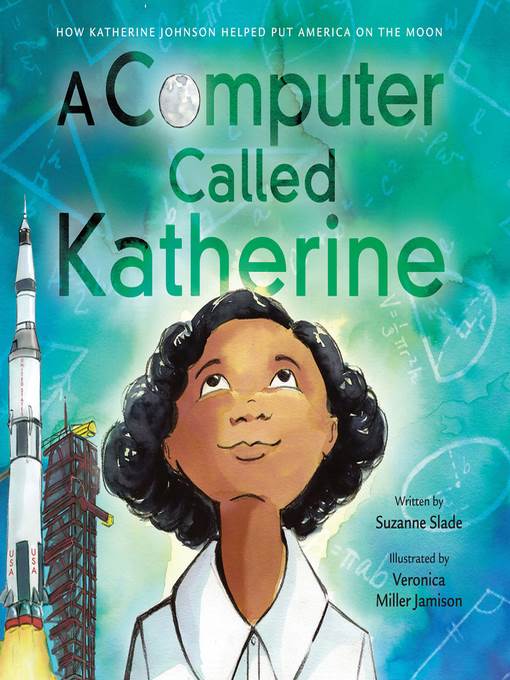
A Computer Called Katherine
How Katherine Johnson Helped Put America on the Moon
فرمت کتاب
audiobook
تاریخ انتشار
2019
Lexile Score
760
Reading Level
3-4
ATOS
4.3
Interest Level
K-3(LG)
نویسنده
Jeanette Illidgeناشر
Hachette Audioشابک
9781549156281
کتاب های مرتبط
- اطلاعات
- نقد و بررسی
- دیدگاه کاربران
نقد و بررسی

December 21, 2018
K-Gr 3-Even as a child, Katherine Johnson loved numbers. She skipped through school, took a job as part of a team of number crunchers called "calculators," and helped figure out the trajectory of early space flights of the 1960s, even after machine computing became a part of the process. This retelling of Johnson's achievements focuses on her path as a black female mathematician. The book devotes a spread to the civil rights struggle, illustrating how people were divided about school integration; it also shows that many disagreed about whether women should work at jobs traditionally held by men. Jamison stresses how Johnson's talent for math broke both barriers. Covering much of the same ground as Helaine Becker's Counting on Katherine, the text is relatively straightforward and accessible even to listeners not yet ready for the inclusion of incorrect math problems, such as "25 ÷ 5 = 4," used as examples of how wrong some people's assumptions were. First-time illustrator Jamison relies on ink, watercolor, marker, and colored pencil to create spreads that emphasize math concepts. Often there's a faint background of the geometric images and equations shown on the end papers. Back matter includes author and artist notes about their personal connection to the subject, quotes from Johnson herself, and sources and credits. VERDICT Another appealing picture book biography of a successful woman; a strong choice for most collections.-Kathleen Isaacs, Children's Literature Specialist, Pasadena, MD
Copyright 1 School Library Journal, LLC Used with permission.
Starred review from December 1, 2018
Katherine Johnson had a passion for numbers and made herself indispensable to the early space program.On the heels of the acclaimed book Hidden Figures, by Margot Lee Shetterly (2016), and the film of the same name, this picture book tells of one of NASA's human computers, Katherine Johnson. Katherine skipped both first and fifth grades because of her math skills, which put her ahead of her older brother in school. She finished eighth grade at age 10 and started college at 15. Throughout this compellingly told biography, the narrator compares social wrongs to miscalculated math problems, as in the sexist belief that "women could only be teachers or nurses. Katherine knew that was wrong--as wrong as 10 - 5 = 3." She also objected to segregation and to her exclusion from meetings at Langley Aeronautical Laboratory that had only ever been attended by men. Because she broke barriers that sought to limit her abilities, Katherine stands as an important example of persisting to make change. Illustrator Jamison beautifully conveys in illuminating watercolors both how much Katherine enjoyed numbers and how determined she was to succeed in a male-dominated field. Informative backmatter includes a historical timeline and notes from the author and illustrator.An excellent way to introduce young readers to an African-American female mathematician who deserves to be remembered and celebrated. (Picture book/biography. 4-8)
COPYRIGHT(2018) Kirkus Reviews, ALL RIGHTS RESERVED.

Jeanette Illidge exudes confidence and pride as she narrates the early life of Katherine Johnson. A pioneering African-American mathematician who entered college at age 15, Katherine recognized the inequality of educational opportunities for women of color. As part of the National Advisory Committee for Aeronautics, she out-calculated the computers while preparing for both Alan Shepard's and John Glenn's space flights. Illidge is upbeat sharing anecdotes both light--the joy of counting ANYTHING--and somber--exclusion from an all-white high school and the meetings of fellow mathematicians. Illidge's steady pacing mirrors Katherine's own determination to be the best at what she does. Illidge underscores Katherine's belief in women's equality and the power of asking questions. A.R. � AudioFile 2019, Portland, Maine

February 1, 2019
Grades 1-3 Math came easy to Katherine Johnson while she was growing up. In the 1950s, when she was in her 30s, she was hired at NASA as a computer (a female mathematician who assisted the male engineers) and eventually worked her way up to the Apollo 11 project. Vignettes of Katherine's work?familiar to aficionados of the 2016 film Hidden Figures?depict her talent with calculations, the drama of early space travel, and the way both combined to put humans on the moon. There are a few missed opportunities?just how groundbreaking Katherine's work was for the time, given her gender and race, isn't fully conveyed. Still, Slade, herself a rocket engineer, cleverly integrates topical concepts within the text, and the strong back matter includes a time line and source notes. For younger readers, the racist arguments Katherine's African American family faces are depicted as being as wrong as 5 + 5 = 12. Wide pages offer appropriate room for the engaging mixed-media illustrations (don't miss the endpapers!), which wonderfully introduce, depict, and honor this STEM heroine.(Reprinted with permission of Booklist, copyright 2019, American Library Association.)

























دیدگاه کاربران